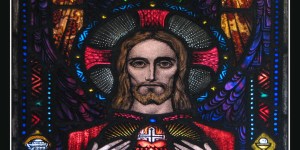Lenten Campaign 2025
This content is free of charge, as are all our articles.
Support us with a donation that is tax-deductible and enable us to continue to reach millions of readers.
In honor of Pope Francis’ latest encyclical, “Dilexit Nos - Encyclical Letter on the Human and Divine Love of the Heart of Jesus Christ,” Aleteia is reflecting on years of devotion to the Sacred Heart of Jesus.
We’ve covered many aspects of the Sacred Heart over the years, from devotions to original works of art by contemporary artists. Today, however, we’re looking back at a few of the oldest and most mysterious images of the Sacred Heart that history has to offer.
This is one of the oldest depictions of the Sacred Heart
While the devotion to the Sacred Heart of Jesus was popularized in the 17th century, feasts to honor the wounds of Christ have been celebrated since at least the 14th century. Before the revelations of St. Margaret Mary Alacoque, to whom Jesus granted private revelations about the Sacred Heart, there were small groups of Christians following the devotion in England, Spain, and Italy.
There is an early depiction of the Sacred Heart in an English manuscript dated between 1490 - 1500. The five wounds are depicted on disembodied hands and feet surrounding a heart that bleeds into a chalice. This again makes an obvious connection between the Passion, the Sacred Heart, and the gift of the Eucharist.
Auschwitz’s cell 21 still bears this carving of the Sacred Heart
In the infamous WWII prison camp, Auschwitz, there is no shortage of inspirational tales of Catholic perseverance in the face of persecution. It was there that St. Maximilian Kolbe sacrificed himself to save a Jewish man, who survived captivity and went on to attend Kolbe’s beatification. St. Maximilian Kolbe’s example is one that has inspired and will inspire devotion for generations.
Around the corner from the cell where St. Maximilian Kolbe met his fate, another example of the endurance of the Catholic faith persists. There, in prison cell 21, are two carvings: The Most Sacred Heart of Jesus, and the Crucifixion.
Mysterious 250-year-old stone inscription bears the Sacred Heart
In 2019, the town of Plougastel-Daoulas in Brittany, France, discovered a rock that bears a curious inscription. Carved into the stone are about 20 lines of an indecipherable language, which includes characters from the Scandinavian written language (like the Ø letter), as well as some non-alphabetical characters like an engraving of a sailboat and even the Sacred Heart.
While it is still unknown who carved the inscription, some believe that the presence of the Sacred Heart image is indicative of their Catholic origins. The inscription, worn by time, may never be properly identified or translated, but it is a lasting testament to the faith of Catholics of old.










